Terry Odell's Blog, page 254
April 19, 2012
Trends in Publishing?
What I'm reading: Alibi in High Heels, by Gemma Halliday (Nook); Killing Kate, by Julie Kramer
First - for those with Kindles, SAVING SCOTT is now available at the Kindle Store, and at Smashwords. Other e-tailers coming soon.
[image error] I'm headed out to the Pikes Peak Writers Conference this afternoon. I'll admit that I'm looking forward to a fan-girl moment at dinner tonight, where I'll be seated at a table with author Robert Crais. I shall try not to blather. Or drool. I love his Elvis Cole/Joe Pike books, and years ago, when he spoke at SleuthFest, he was very nice about answering this not-yet-published author's questions, and offered encouragement.
I'll try to take notes during the workshops and have recaps next week.
I've been judging a contest for published romantic suspense books. I was given four books to judge, and I noticed something different about this years' entries. All four of mine were from small presses, most of which I'd never heard of. Yet they're all legitimate, royalty-paying publishing houses.
I know I've talked about going indie with e-books, but here's another print alternative to the Big Six. These aren't 'vanity presses' where the author pays to have his book published. These are publishers that require authors to submit manuscripts for approval, the same way the New York biggies do. They provide editorial services and cover art. I think they rely more on the authors for marketing, but nowadays, the Big Six also expect authors to be their own promoters.
Differences?
Most of these small presses rely on POD, or "Print on Demand" to create their product. Not that long ago, POD publishing was scoffed at, and lumped in with vanity presses. However, POD is a technology, and is not connected with publishers. All it means is that if someone orders a book, instead of finding it on a warehouse shelf, it's printed virtually on the spot. This saves trees, and eliminates the stripped book returns from bookstores.
Indie authors can take advantage of POD technology as well. For example, my two indie published books, DANGER IN DEER RIDGE, and DEADLY SECRETS, are available in print as well as in digital formats. If you go to either Amazon.com or Create Space, you can order the book, and it'll be shipped to you, the same as any other traditionally published book.
So, maybe as the Big Six are trying to figure out what's happening in the publishing world, the little guys are stepping in to fill the gaps. And not only do authors benefit, but readers can experience books that might not fit the confines of the Big Six.
Like this post? Please share by clicking one of the links below.
First - for those with Kindles, SAVING SCOTT is now available at the Kindle Store, and at Smashwords. Other e-tailers coming soon.
[image error] I'm headed out to the Pikes Peak Writers Conference this afternoon. I'll admit that I'm looking forward to a fan-girl moment at dinner tonight, where I'll be seated at a table with author Robert Crais. I shall try not to blather. Or drool. I love his Elvis Cole/Joe Pike books, and years ago, when he spoke at SleuthFest, he was very nice about answering this not-yet-published author's questions, and offered encouragement.
I'll try to take notes during the workshops and have recaps next week.
I've been judging a contest for published romantic suspense books. I was given four books to judge, and I noticed something different about this years' entries. All four of mine were from small presses, most of which I'd never heard of. Yet they're all legitimate, royalty-paying publishing houses.
I know I've talked about going indie with e-books, but here's another print alternative to the Big Six. These aren't 'vanity presses' where the author pays to have his book published. These are publishers that require authors to submit manuscripts for approval, the same way the New York biggies do. They provide editorial services and cover art. I think they rely more on the authors for marketing, but nowadays, the Big Six also expect authors to be their own promoters.
Differences?
Most of these small presses rely on POD, or "Print on Demand" to create their product. Not that long ago, POD publishing was scoffed at, and lumped in with vanity presses. However, POD is a technology, and is not connected with publishers. All it means is that if someone orders a book, instead of finding it on a warehouse shelf, it's printed virtually on the spot. This saves trees, and eliminates the stripped book returns from bookstores.
Indie authors can take advantage of POD technology as well. For example, my two indie published books, DANGER IN DEER RIDGE, and DEADLY SECRETS, are available in print as well as in digital formats. If you go to either Amazon.com or Create Space, you can order the book, and it'll be shipped to you, the same as any other traditionally published book.
So, maybe as the Big Six are trying to figure out what's happening in the publishing world, the little guys are stepping in to fill the gaps. And not only do authors benefit, but readers can experience books that might not fit the confines of the Big Six.
Like this post? Please share by clicking one of the links below.
Published on April 19, 2012 04:00
April 18, 2012
What's Cooking Wednesday - Crockpot Quiche
As I'm sitting here watching the snow fall, I figured this recipe, contributed by frequent visitor to Terry's Place, Karen C, might make a tasty dinner. (Although, as I'm typing this, it's Sunday afternoon, and we usually go out to our local pub for dinner. But if Karen says it's good, I'm sure it is.) Thanks, Karen!
Karen says: Feel free to improvise with whatever vegetables you have on hand. Try asparagus, mushrooms, peppers, onions or a mixture. You will need about 3 cups of cooked vegetables.
Ingredients:
Unsalted Butter
6 large eggs
2 tablespoons all-purpose flour
½ teaspoon salt
1/8 teaspoon freshly grated nutmeg
Freshly ground pepper
1 cup half-and-half
1 cup whole milk
3 cups chopped well-drained cooked broccoli or other vegetables
2 tablespoons minced fresh tarragon or basil
1 cup grated Gruyere, Emmentaler, Gouda or cheddar cheese (or a mixture)
1 cup freshly grated Parmigiano-Reggiano
Instructions:
1. Generously butter a large slow cooker. (I used a cooking spray.)
2. Beat eggs together with flour, salt, nutmeg, and pepper to taste. Whisk in half-and-half and milk. Stir in broccoli, herbs, Gruyere and ½ cup of the Parmigiano-Reggiano.
3. Pour mixture into slow cooker. Sprinkle remaining ½ cup Parmigiano-Reggiano over top. Cover and cook on HIGH for 1 ½ hours or until quiche is just set in the center. Run a knife around edge of quiche, cut into wedges and serve hot.
Like this post? Please share by clicking one of the links below.
Karen says: Feel free to improvise with whatever vegetables you have on hand. Try asparagus, mushrooms, peppers, onions or a mixture. You will need about 3 cups of cooked vegetables.
Ingredients:
Unsalted Butter
6 large eggs
2 tablespoons all-purpose flour
½ teaspoon salt
1/8 teaspoon freshly grated nutmeg
Freshly ground pepper
1 cup half-and-half
1 cup whole milk
3 cups chopped well-drained cooked broccoli or other vegetables
2 tablespoons minced fresh tarragon or basil
1 cup grated Gruyere, Emmentaler, Gouda or cheddar cheese (or a mixture)
1 cup freshly grated Parmigiano-Reggiano
Instructions:
1. Generously butter a large slow cooker. (I used a cooking spray.)
2. Beat eggs together with flour, salt, nutmeg, and pepper to taste. Whisk in half-and-half and milk. Stir in broccoli, herbs, Gruyere and ½ cup of the Parmigiano-Reggiano.
3. Pour mixture into slow cooker. Sprinkle remaining ½ cup Parmigiano-Reggiano over top. Cover and cook on HIGH for 1 ½ hours or until quiche is just set in the center. Run a knife around edge of quiche, cut into wedges and serve hot.
Like this post? Please share by clicking one of the links below.
Published on April 18, 2012 04:00
April 17, 2012
The Power of Point of View
I’d like to welcome Vonnie Davis to my blog today. Vonnie is a romance author of contemporary, historical and romantic suspense. She’s also held workshops on Savvy Authors. Today, she's offering her insights on one of my favorite topics, Point of View. And while she's here, I'm doing my monthly post at
The Blood-Red Pencil
.
Thank you for having me, Terry.
I’d like to share some thoughts about the bane of my existence when I first began writing full time—point of view.
You see, I’d majored in English and retired as a technical writer. So I knew how to craft a sentence. What I didn’t know was the craft of writing. Character arc? Conflict resolution? Dialog tags and beats? GMC? Isn’t that a truck? Point of view? After all the classical literature I’d studied, I certainly knew about that. I was good to go.
Yes, folks, I was blissfully ignorant.
My soon-to-be agent phoned to tell me I had some real point of view issues. When I told her I was using third person omniscient, I’m sure I heard her fall out of her chair laughing.
My learning curve just shot upward at a forty-five degree angle.
Gee, and I thought I knew so much.
Yet editors cite point of view (POV) errors as the main reason manuscripts are rejected. POV is more than whose head are we in. Properly used, POV is a writer’s tool to draw the reader into the story to the degree that when the reader reaches the end, the reader says, “Man, I just couldn’t put it down.”
If Darla is your POV character, you can only show us what Darla sees, hears, smells, tastes, feels and thinks.
Think about it. Isn’t that how you perceive the world?
Can you read minds or feel another person’s worry or scheming motives? No. Neither can your POV character. When you’re talking on the phone can you see the other person’s movements? No. Neither can your POV character.
This restrictiveness and uncertainty feels more realistic because it's how we perceive the world.
You can’t write about things the viewpoint character can't know. You can’t write that your POV character didn’t notice the car following him. If your POV character doesn’t know it, then you can’t write about it. Can your POV character hear criminals whisper in another room or see a younger brother stick out his tongue behind the POV character? Not hardly. So don’t tell your readers about it.
Writers often inadequately utilize point of view. I’m not talking about head-hopping. I’m talking about a very distant use of point of view that doesn’t get the reader into the character’s head or emotions.
Avoid using “she heard” or “he saw” or “she thought.” These phrases distance the reader from the character and are not needed. If we are in Jason’s POV, for example, the reader already knows you, the writer, are writing about what Jason experiences. Let me show you—
Jason pulled out of the driveway for his first solo drive to the mall. He watched his mother wave and heard his dad issue one final safety warning. Man, he thought this day would never come. For the first time in his life he felt free.
Without those “distancers,” you can get us deeper into Jason’s head by writing Jason pulled out of the driveway for his first solo drive to the mall. His mother waved and his overprotective dad yelled one final safety warning. At long last, he was on his own. What a feeling of freedom. Awesome didn’t begin to describe it.
Now we can feel his excitement. We can almost visualize his smile. And by being in his head, sharing his experience, we feel the power of the scene.
If we want our characters to be realistic, then we must infuse them with realistic emotions. I don’t know what it’s like to be chased by a werewolf, but I have been chased by a swarm of bees. So I take the memory of that experience—the fear, the flush of heat on my chest, my heart pounding in my ears and the clenching of my stomach—and ramp it up a degree for my POV character.
Don’t tell the reader Darla was angry. That’s so lame. Show the roar in her ears as her heart beats faster, the ache in her jaw from gritting her teeth and the pain in her palms from her fingernails pressing into them as she clenches her fists. Make us feel her anger by taking us deeper into Darla’s POV. Show the reader these things and the reader will think man, is she angry. Your reader becomes part of the story because he or she feels it.
There’s great power in point of view. It’s more than whose head are we in. By utilizing its power, we become authors of page-turners.
For more about Vonnie, you can find her at her blog, her website, and on Twitter as @VonnieWrites
Like this post? Please share by clicking one of the links below.
Thank you for having me, Terry.
I’d like to share some thoughts about the bane of my existence when I first began writing full time—point of view.
You see, I’d majored in English and retired as a technical writer. So I knew how to craft a sentence. What I didn’t know was the craft of writing. Character arc? Conflict resolution? Dialog tags and beats? GMC? Isn’t that a truck? Point of view? After all the classical literature I’d studied, I certainly knew about that. I was good to go.
Yes, folks, I was blissfully ignorant.
My soon-to-be agent phoned to tell me I had some real point of view issues. When I told her I was using third person omniscient, I’m sure I heard her fall out of her chair laughing.
My learning curve just shot upward at a forty-five degree angle.
Gee, and I thought I knew so much.
Yet editors cite point of view (POV) errors as the main reason manuscripts are rejected. POV is more than whose head are we in. Properly used, POV is a writer’s tool to draw the reader into the story to the degree that when the reader reaches the end, the reader says, “Man, I just couldn’t put it down.”
If Darla is your POV character, you can only show us what Darla sees, hears, smells, tastes, feels and thinks.
Think about it. Isn’t that how you perceive the world?
Can you read minds or feel another person’s worry or scheming motives? No. Neither can your POV character. When you’re talking on the phone can you see the other person’s movements? No. Neither can your POV character.
This restrictiveness and uncertainty feels more realistic because it's how we perceive the world.
You can’t write about things the viewpoint character can't know. You can’t write that your POV character didn’t notice the car following him. If your POV character doesn’t know it, then you can’t write about it. Can your POV character hear criminals whisper in another room or see a younger brother stick out his tongue behind the POV character? Not hardly. So don’t tell your readers about it.
Writers often inadequately utilize point of view. I’m not talking about head-hopping. I’m talking about a very distant use of point of view that doesn’t get the reader into the character’s head or emotions.
Avoid using “she heard” or “he saw” or “she thought.” These phrases distance the reader from the character and are not needed. If we are in Jason’s POV, for example, the reader already knows you, the writer, are writing about what Jason experiences. Let me show you—
Jason pulled out of the driveway for his first solo drive to the mall. He watched his mother wave and heard his dad issue one final safety warning. Man, he thought this day would never come. For the first time in his life he felt free.
Without those “distancers,” you can get us deeper into Jason’s head by writing Jason pulled out of the driveway for his first solo drive to the mall. His mother waved and his overprotective dad yelled one final safety warning. At long last, he was on his own. What a feeling of freedom. Awesome didn’t begin to describe it.
Now we can feel his excitement. We can almost visualize his smile. And by being in his head, sharing his experience, we feel the power of the scene.
If we want our characters to be realistic, then we must infuse them with realistic emotions. I don’t know what it’s like to be chased by a werewolf, but I have been chased by a swarm of bees. So I take the memory of that experience—the fear, the flush of heat on my chest, my heart pounding in my ears and the clenching of my stomach—and ramp it up a degree for my POV character.
Don’t tell the reader Darla was angry. That’s so lame. Show the roar in her ears as her heart beats faster, the ache in her jaw from gritting her teeth and the pain in her palms from her fingernails pressing into them as she clenches her fists. Make us feel her anger by taking us deeper into Darla’s POV. Show the reader these things and the reader will think man, is she angry. Your reader becomes part of the story because he or she feels it.
There’s great power in point of view. It’s more than whose head are we in. By utilizing its power, we become authors of page-turners.
For more about Vonnie, you can find her at her blog, her website, and on Twitter as @VonnieWrites
Like this post? Please share by clicking one of the links below.
Published on April 17, 2012 04:00
April 16, 2012
Etiquette Tips for Author Events - And a Nook First Recap
What I'm reading: Contest entry 3 of 4; In Plain Sight, by C.J. Box
First – a quick Nook First recap. My 30 day commitment is almost over (and thanks to those who—I hope—have been patiently waiting for SAVING SCOTT to be available for all the other e-reading devices out there). Sales are, as expected, dropping off, but are still far more than what I'd seen at Barnes & Noble prior to the Nook First campaign
Before Nook First, I was very pleased with my Amazon sales. I still am, but I thought a quick comparison might be in order. Remember, this is "regular" Amazon, not their Select program. I've never done free giveaways there.
Amazon sales, all my titles, between March 19th and April 14th: 2,329.Barnes & Noble sales, all my titles, same date range: 13,824.Adjusted Barnes & Noble Sales, excluding SAVING SCOTT, which isn't available at Amazon: 9,270.
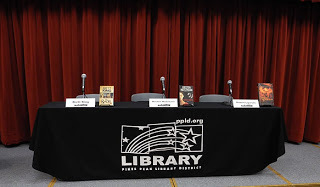 On Saturday, I participated in a library program, Mountain of Authors, at one of the Pikes Peak library branches. There were panels on thrillers and on e-publishing, as well as a keynote speech by author Connie Willis. In addition, between the panel discussions, local authors (myself included) were "showcased" and allowed to introduce themselves, their work, and sell books to help raise money for their Friends of the Library.
On Saturday, I participated in a library program, Mountain of Authors, at one of the Pikes Peak library branches. There were panels on thrillers and on e-publishing, as well as a keynote speech by author Connie Willis. In addition, between the panel discussions, local authors (myself included) were "showcased" and allowed to introduce themselves, their work, and sell books to help raise money for their Friends of the Library.
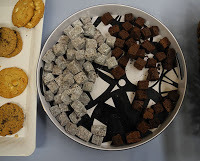
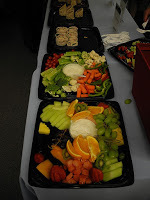 (And there were a few perks. Hubster came along to "see what you really do" but I think he came because, as my guest, he got a free lunch.
(And there were a few perks. Hubster came along to "see what you really do" but I think he came because, as my guest, he got a free lunch.
There were 32 authors present. We tend to get wrapped up in our own genres, and forget that there are publishing genres for just about everyone. There were children's books, non-fiction books, niche market books, as well as the usual genre fiction.
I was interested in the panel on e-publishing. The takeaway there is that if you've got books published, the more formats you can offer them in, the better. But there IS a difference between books published in e-format by recognized publishers and indie, or self-publishing a book. As I'm sure I've said before, e-publishing should never be a shortcut. Make sure you've got a quality product, which requires investing time and usually money in good editing. Having your mother tell you your book is great is not a good reason to self-publish. But if you've got a good book, perhaps in a narrow niche market, where no publisher will take it because your target audience is too small, e-publishing offers you the opportunity to get it out there.
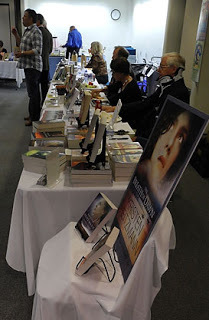
As for the 'showcase' side of the program.
If you're an author:
Follow the rules
Authors were told they had ONE MINUTE to promo themselves. This isn't much time, so it behooves you to have an idea of what points you want to make. The program director didn't use a stopwatch, so people weren't warned to keep it short, or cut off when their time was up.
If you've written 4 books, don't spend even 30 seconds telling what each is about and why you wrote it. That's two minutes right there.
It's really not fair to exploit the "rules." The result of those long-winded authors meant that the 'meet and greet' time was drastically shortened in order to keep the rest of the program on schedule.
(And maybe, if you're the one in charge, you should try to make sure these time constraints are met)
Don't preach.
Even if you're publishing books about a topic you strongly believe in, don't try to convert the audience in your allotted time. There's time for that when people come to your table.
Don't expect to sell a ton of books. Book signings and other events (unless you're a big name) don't really mean sales. They mean meeting people. And, at a library, most of the attendees are people who get their books from the library!
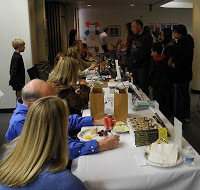
If you're an attendee:
Don't pretend the author isn't there if you aren't interested in their particular books. Smile. Stop to chat. Authors love meeting people. Don't think that you have to buy, especially in a room with 32 authors. They know their books won't be 'right' for everyone, and don't expect a purchase from everyone who stops by.
Tomorrow, my guest is Vonnie Davis, who's going to be sharing her take on POV, one of my favorite topics.
Like this post? Please share by clicking one of the links below.
First – a quick Nook First recap. My 30 day commitment is almost over (and thanks to those who—I hope—have been patiently waiting for SAVING SCOTT to be available for all the other e-reading devices out there). Sales are, as expected, dropping off, but are still far more than what I'd seen at Barnes & Noble prior to the Nook First campaign
Before Nook First, I was very pleased with my Amazon sales. I still am, but I thought a quick comparison might be in order. Remember, this is "regular" Amazon, not their Select program. I've never done free giveaways there.
Amazon sales, all my titles, between March 19th and April 14th: 2,329.Barnes & Noble sales, all my titles, same date range: 13,824.Adjusted Barnes & Noble Sales, excluding SAVING SCOTT, which isn't available at Amazon: 9,270.
 On Saturday, I participated in a library program, Mountain of Authors, at one of the Pikes Peak library branches. There were panels on thrillers and on e-publishing, as well as a keynote speech by author Connie Willis. In addition, between the panel discussions, local authors (myself included) were "showcased" and allowed to introduce themselves, their work, and sell books to help raise money for their Friends of the Library.
On Saturday, I participated in a library program, Mountain of Authors, at one of the Pikes Peak library branches. There were panels on thrillers and on e-publishing, as well as a keynote speech by author Connie Willis. In addition, between the panel discussions, local authors (myself included) were "showcased" and allowed to introduce themselves, their work, and sell books to help raise money for their Friends of the Library.
 (And there were a few perks. Hubster came along to "see what you really do" but I think he came because, as my guest, he got a free lunch.
(And there were a few perks. Hubster came along to "see what you really do" but I think he came because, as my guest, he got a free lunch. There were 32 authors present. We tend to get wrapped up in our own genres, and forget that there are publishing genres for just about everyone. There were children's books, non-fiction books, niche market books, as well as the usual genre fiction.
I was interested in the panel on e-publishing. The takeaway there is that if you've got books published, the more formats you can offer them in, the better. But there IS a difference between books published in e-format by recognized publishers and indie, or self-publishing a book. As I'm sure I've said before, e-publishing should never be a shortcut. Make sure you've got a quality product, which requires investing time and usually money in good editing. Having your mother tell you your book is great is not a good reason to self-publish. But if you've got a good book, perhaps in a narrow niche market, where no publisher will take it because your target audience is too small, e-publishing offers you the opportunity to get it out there.

As for the 'showcase' side of the program.
If you're an author:
Follow the rules
Authors were told they had ONE MINUTE to promo themselves. This isn't much time, so it behooves you to have an idea of what points you want to make. The program director didn't use a stopwatch, so people weren't warned to keep it short, or cut off when their time was up.
If you've written 4 books, don't spend even 30 seconds telling what each is about and why you wrote it. That's two minutes right there.
It's really not fair to exploit the "rules." The result of those long-winded authors meant that the 'meet and greet' time was drastically shortened in order to keep the rest of the program on schedule.
(And maybe, if you're the one in charge, you should try to make sure these time constraints are met)
Don't preach.
Even if you're publishing books about a topic you strongly believe in, don't try to convert the audience in your allotted time. There's time for that when people come to your table.
Don't expect to sell a ton of books. Book signings and other events (unless you're a big name) don't really mean sales. They mean meeting people. And, at a library, most of the attendees are people who get their books from the library!

If you're an attendee:
Don't pretend the author isn't there if you aren't interested in their particular books. Smile. Stop to chat. Authors love meeting people. Don't think that you have to buy, especially in a room with 32 authors. They know their books won't be 'right' for everyone, and don't expect a purchase from everyone who stops by.
Tomorrow, my guest is Vonnie Davis, who's going to be sharing her take on POV, one of my favorite topics.
Like this post? Please share by clicking one of the links below.
Published on April 16, 2012 04:00
April 13, 2012
Friday Field Trip - Sedona
First, I hope nobody suffers from triskaidekaphobia. If so, hope your day is a safe one.
Today's field trip comes courtesy of Karen C, a regular here at Terry's Place. We're going to Sedona. Thanks so much!





Like this post? Please share by clicking one of the links below.
Today's field trip comes courtesy of Karen C, a regular here at Terry's Place. We're going to Sedona. Thanks so much!





Like this post? Please share by clicking one of the links below.
Published on April 13, 2012 04:00
April 12, 2012
Tips for a Radio Interview
What I'm reading: In Plain Sight, by C.J. Box; Alibi in High Heels, by Gemma Halliday (Nook)
 Tonight I'm headed into new territory. I had a request for a web radio interview, and I accepted. My first reaction when I got the confirmation was panic. Had I really agreed to do this? The show is scheduled for three hours. THREE? Now, talking doesn't usually bother me, but I do tend to ramble blather, and I don't think my verbal meanderings would interest listeners for that long.
Tonight I'm headed into new territory. I had a request for a web radio interview, and I accepted. My first reaction when I got the confirmation was panic. Had I really agreed to do this? The show is scheduled for three hours. THREE? Now, talking doesn't usually bother me, but I do tend to ramble blather, and I don't think my verbal meanderings would interest listeners for that long.
Fortunately, follow up emails revealed that there are a whole bunch of authors who will share that time block, with each given a featured half hour. That seems more reasonable.
Since I've never done a phone-in interview before, I thought it might be wise to plan ahead. Stammering and hemming and hawing probably won't make a good impression.
Elaine, the interviewer and host, sent some very useful instructions, including reminders that the station will pick up background sounds. Not smart to be chatting while washing dishes (but Hubster does that), doing laundry, or dealing with pets and vocal children demanding attention. Luckily, we don't have any of the latter, and simply closing the door to my office should keep things quiet. The other critical point is to turn off the sound on the computer, because it'll create nothing but confusion.
I remember calling in to a radio talk show long ago. There's a several second delay between when you speak and when it hits the air. If you've ever tried talking while hearing your words played back a few seconds later…well, it can't be done.
Once the technical aspects are covered, the next most important thing to do is look over the questions the interviewer provided, and make sure I have at least the starting point for answers written down. My brain will go blank otherwise.
And, speaking of blanked-out brains. I'm going to have the titles of all my books written down, too. Nothing like not remembering what you've written (and one of her questions was, "how many books have you written?" and I had to stop and think—and check my own website to make sure I wasn't missing any.)
I'll also jot down the tag line for each book, and the names of the characters, just to help me keep things straight. Upcoming releases. The URL for my website. A plug for my newsletter.
It's a call-in show, so there's another thing to worry about. What if nobody calls in? I know it's the host's job to keep things going, but I'm sure they'd rather have me fielding questions from listeners rather than having to fill the time slot with … filler.
The last interview question is, "anything else about yourself you would like to get out there?"
So, tell me. What do you want to know about me? What do you think listeners might be interested in?
The radio show runs from 8-11 PM Eastern Time. My slot is 9:30 – 10:00 (which is 7:30 – 8:00 Mountain time, where I live, so I might not be asleep.)
You can find the show at trianglevarietyradio.com Scroll down and click on Blog Talk Radio.
The call-in number is on the site.
It would be great to hear from you!
Like this post? Please share by clicking one of the links below.
 Tonight I'm headed into new territory. I had a request for a web radio interview, and I accepted. My first reaction when I got the confirmation was panic. Had I really agreed to do this? The show is scheduled for three hours. THREE? Now, talking doesn't usually bother me, but I do tend to ramble blather, and I don't think my verbal meanderings would interest listeners for that long.
Tonight I'm headed into new territory. I had a request for a web radio interview, and I accepted. My first reaction when I got the confirmation was panic. Had I really agreed to do this? The show is scheduled for three hours. THREE? Now, talking doesn't usually bother me, but I do tend to ramble blather, and I don't think my verbal meanderings would interest listeners for that long.Fortunately, follow up emails revealed that there are a whole bunch of authors who will share that time block, with each given a featured half hour. That seems more reasonable.
Since I've never done a phone-in interview before, I thought it might be wise to plan ahead. Stammering and hemming and hawing probably won't make a good impression.
Elaine, the interviewer and host, sent some very useful instructions, including reminders that the station will pick up background sounds. Not smart to be chatting while washing dishes (but Hubster does that), doing laundry, or dealing with pets and vocal children demanding attention. Luckily, we don't have any of the latter, and simply closing the door to my office should keep things quiet. The other critical point is to turn off the sound on the computer, because it'll create nothing but confusion.
I remember calling in to a radio talk show long ago. There's a several second delay between when you speak and when it hits the air. If you've ever tried talking while hearing your words played back a few seconds later…well, it can't be done.
Once the technical aspects are covered, the next most important thing to do is look over the questions the interviewer provided, and make sure I have at least the starting point for answers written down. My brain will go blank otherwise.
And, speaking of blanked-out brains. I'm going to have the titles of all my books written down, too. Nothing like not remembering what you've written (and one of her questions was, "how many books have you written?" and I had to stop and think—and check my own website to make sure I wasn't missing any.)
I'll also jot down the tag line for each book, and the names of the characters, just to help me keep things straight. Upcoming releases. The URL for my website. A plug for my newsletter.
It's a call-in show, so there's another thing to worry about. What if nobody calls in? I know it's the host's job to keep things going, but I'm sure they'd rather have me fielding questions from listeners rather than having to fill the time slot with … filler.
The last interview question is, "anything else about yourself you would like to get out there?"
So, tell me. What do you want to know about me? What do you think listeners might be interested in?
The radio show runs from 8-11 PM Eastern Time. My slot is 9:30 – 10:00 (which is 7:30 – 8:00 Mountain time, where I live, so I might not be asleep.)
You can find the show at trianglevarietyradio.com Scroll down and click on Blog Talk Radio.
The call-in number is on the site.
It would be great to hear from you!
Like this post? Please share by clicking one of the links below.
Published on April 12, 2012 04:00
April 11, 2012
What's Cooking Wednesday - Kale Salad with Asian Dressing
What I'm reading: Contest Entry 2 of 4
First, I was hit with a bunch of interview questions for Candice Coghill's blog. Hop over and see if you learn anything new. (And leave a comment if you have a moment.)
On to the recipe of the week: My mom made a yummy kale salad while we visited her in Los Angeles prior to the LA Marathon. I replicated it, more or less, when I got home, and added shrimp to make it a main dish. It's one of those "anything goes" recipes.
Kale Salad with Shrimp and Asian Dressing

Salad –
No rules here; use as much as you like, add other favorites or delete things you don't like. For most of the ingredients, I'd ballpark about 8 ounces. Depends on how many people you're feeding, and what you like.
1 bunch kale, stems removed, chopped. (Would work with any greens.)
Frozen shelled edamame (soy beans), cooked per package directions & cooled.
Dried cherries (or craisins, blueberries, cranberries)
Slivered almonds
Cherry tomatoes, halved
1-2 T toasted sesame seeds
Frozen salad-sized shrimp, thawed and drained well. (for a side-dish salad, you can leave this out)
Asian Dressing (this will make more than you need; save the rest for other salads.)
1/4 c soy sauce
2 T. rice vinegar
1 T. lemon juice
1/2 t. sesame oil
1 T honey
1/2 t garlic powder
1/4 t dried ginger (or 1 t fresh, grated)
1/4 c salad oil.
Salt, pepper to taste.
Mix everything together.
Like this post? Please share by clicking one of the links below.
First, I was hit with a bunch of interview questions for Candice Coghill's blog. Hop over and see if you learn anything new. (And leave a comment if you have a moment.)
On to the recipe of the week: My mom made a yummy kale salad while we visited her in Los Angeles prior to the LA Marathon. I replicated it, more or less, when I got home, and added shrimp to make it a main dish. It's one of those "anything goes" recipes.
Kale Salad with Shrimp and Asian Dressing

Salad –
No rules here; use as much as you like, add other favorites or delete things you don't like. For most of the ingredients, I'd ballpark about 8 ounces. Depends on how many people you're feeding, and what you like.
1 bunch kale, stems removed, chopped. (Would work with any greens.)
Frozen shelled edamame (soy beans), cooked per package directions & cooled.
Dried cherries (or craisins, blueberries, cranberries)
Slivered almonds
Cherry tomatoes, halved
1-2 T toasted sesame seeds
Frozen salad-sized shrimp, thawed and drained well. (for a side-dish salad, you can leave this out)
Asian Dressing (this will make more than you need; save the rest for other salads.)
1/4 c soy sauce
2 T. rice vinegar
1 T. lemon juice
1/2 t. sesame oil
1 T honey
1/2 t garlic powder
1/4 t dried ginger (or 1 t fresh, grated)
1/4 c salad oil.
Salt, pepper to taste.
Mix everything together.
Like this post? Please share by clicking one of the links below.
Published on April 11, 2012 04:00
April 10, 2012
Writing as Therapy
Today I welcome Karla Brandenburg to Terry's Place. Karla is the author of contemporary romance, with a hint of the paranormal.
It has been my experience that many writers begin the process as catharsis. Something traumatic happens in their lives and writing is a way to deal with what they've been through. For myself, I started writing as an angst-ridden teen. Back up. Amend that. I actually wrote my first story when I was VERY young (when I was first old enough to put a sentence together – yes, that young). I actually sent it to Random House! Writing was a way to express myself, but I didn't make another serious attempt until my teen years. Even I realized, by the time I'd outgrown all the angst, that the stories I'd written weren't very good, but as a quiet, introverted kind of person, it helped me to deal with things that I had trouble expressing.
As I got older and more vocal/outspoken, I didn't need the outlet quite so much, but expressing myself "on paper" was still easier. I also had a vivid imagination – always. The stories continued to come and I still put them down, just to empty my head. They were less personal, more observational by that time. My imagination conjured up all sorts of stories about the people around me, people I'd never met and didn't know. You might think of this as people watching at the mall, in greater detail.
How many people have you met who said something to the effect of, "Wow, you should write a story about all your experiences!" to you or to someone you know? The fact of the matter is that for most people, it doesn't translate well, partly because the story isn't over yet (so there's no ending), and partly because while you have lived it and experienced it, someone else might not be even remotely interested (or might have a more dramatic story themselves). Don't get me wrong. Certainly, there are some people who have very interesting lives, but consider what I've already told you about myself. Do you really care that I wrote a children's story when I was five (that didn't go anywhere)?
For me, writing has value. Not just for the stories I can weave, but to empty my overactive imagination. Like most authors, I also have a day job. The job is seasonal, so when it's busy, it's VERY BUSY, which limits my creative time. This year in particular, I've been spending more of my writing time cleaning off my shelves than I have starting something new. I have some old stories that I never marketed. Because my creative time is at a premium, I've been "cheating" by revisiting these old stories and developing a marketing plan. Cleaning them up. Writing synopsises (synopsi?). Sending out query letters. And I'm noticing something interesting – which brings me to the topic of this post.
Writing is therapy. Even though my angst-ridden teen years are over. Even though I'm as happy in my life as a person has a right to be. I still have a head filled with imagination, and even though I've put down several story ideas for future reference, without having a new project that I'm throwing myself full into, my imagination is poking and prodding and reminding me that it needs an outlet. I go to bed at night and my dreams are vivid and active. There are song writers that keep notebooks beside their beds so they can capture those unreined imagination moments, moments that evaporate with morning's first light, but I'll be honest, I'm not a fan of most of those songs. I do keep a notebook beside my bed, but not to capture those wild dreams. I use it to capture those moments when my stories creep into my sleep and resolve an issue that I've been struggling with.
I love writing. Always have. As much for escape as catharsis. To my mind, the cathartic stories I've written are usually so much drivel, but I love the freedom to escape into my imagination and take someone on that ride with me. And what I've (re)learned this busy season at work is that for me, those escapes are essential to a good night's sleep - imagination therapy.
I do believe it's time to start a new project!
You can find Karla's book at Amazon.com (or other on-line booksellers), or ebooks in all formats here . For more information, visit her website at www.karlabrandenburg.com Watch for her newest book, Living Canvas, which is expected to be released next month.
Like this post? Please share by clicking one of the links below.
It has been my experience that many writers begin the process as catharsis. Something traumatic happens in their lives and writing is a way to deal with what they've been through. For myself, I started writing as an angst-ridden teen. Back up. Amend that. I actually wrote my first story when I was VERY young (when I was first old enough to put a sentence together – yes, that young). I actually sent it to Random House! Writing was a way to express myself, but I didn't make another serious attempt until my teen years. Even I realized, by the time I'd outgrown all the angst, that the stories I'd written weren't very good, but as a quiet, introverted kind of person, it helped me to deal with things that I had trouble expressing.
As I got older and more vocal/outspoken, I didn't need the outlet quite so much, but expressing myself "on paper" was still easier. I also had a vivid imagination – always. The stories continued to come and I still put them down, just to empty my head. They were less personal, more observational by that time. My imagination conjured up all sorts of stories about the people around me, people I'd never met and didn't know. You might think of this as people watching at the mall, in greater detail.
How many people have you met who said something to the effect of, "Wow, you should write a story about all your experiences!" to you or to someone you know? The fact of the matter is that for most people, it doesn't translate well, partly because the story isn't over yet (so there's no ending), and partly because while you have lived it and experienced it, someone else might not be even remotely interested (or might have a more dramatic story themselves). Don't get me wrong. Certainly, there are some people who have very interesting lives, but consider what I've already told you about myself. Do you really care that I wrote a children's story when I was five (that didn't go anywhere)?
For me, writing has value. Not just for the stories I can weave, but to empty my overactive imagination. Like most authors, I also have a day job. The job is seasonal, so when it's busy, it's VERY BUSY, which limits my creative time. This year in particular, I've been spending more of my writing time cleaning off my shelves than I have starting something new. I have some old stories that I never marketed. Because my creative time is at a premium, I've been "cheating" by revisiting these old stories and developing a marketing plan. Cleaning them up. Writing synopsises (synopsi?). Sending out query letters. And I'm noticing something interesting – which brings me to the topic of this post.
Writing is therapy. Even though my angst-ridden teen years are over. Even though I'm as happy in my life as a person has a right to be. I still have a head filled with imagination, and even though I've put down several story ideas for future reference, without having a new project that I'm throwing myself full into, my imagination is poking and prodding and reminding me that it needs an outlet. I go to bed at night and my dreams are vivid and active. There are song writers that keep notebooks beside their beds so they can capture those unreined imagination moments, moments that evaporate with morning's first light, but I'll be honest, I'm not a fan of most of those songs. I do keep a notebook beside my bed, but not to capture those wild dreams. I use it to capture those moments when my stories creep into my sleep and resolve an issue that I've been struggling with.
I love writing. Always have. As much for escape as catharsis. To my mind, the cathartic stories I've written are usually so much drivel, but I love the freedom to escape into my imagination and take someone on that ride with me. And what I've (re)learned this busy season at work is that for me, those escapes are essential to a good night's sleep - imagination therapy.
I do believe it's time to start a new project!
You can find Karla's book at Amazon.com (or other on-line booksellers), or ebooks in all formats here . For more information, visit her website at www.karlabrandenburg.com Watch for her newest book, Living Canvas, which is expected to be released next month.
Like this post? Please share by clicking one of the links below.
Published on April 10, 2012 04:00
April 9, 2012
Nook First - Week 2, and Writing Series
What I'm reading: Stay Close, by Harlan Coben; Dutch Me Deadly, by Maddy Hunter (bike); Contest entry 1 of 4.
First, a brief summary of my second week at Barnes & Noble. The program puts your book on the home pages for two weeks of the 30 days you've committed to the exclusive, so the first two weeks are where I expected to see the greatest sales. I wasn't disappointed. (If you haven't read my summary of Week 1, click here.)
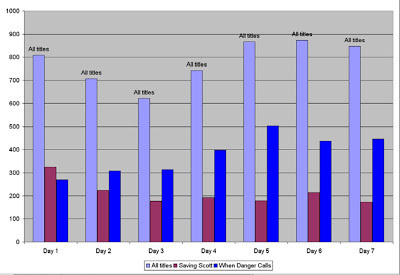
(clicking should enlarge the image)
For Week 2, I had two books on the Top 100 in the Nook Store. All my books moved well up in the rankings, four of them under 500. (Note: my best-selling Amazon titles are in the 3000 – 5000 range, and I've always been happy with that.) I sold over 5000 books that week.
Week 3 is almost over as I write this, and, as expected, my sales have dropped. However, let's put things in perspective. Prior to Nook First, I was thrilled to sell 10 or 20 books a day at Barnes & Noble. In Week 3, my sales are still in the hundreds. So, just because it's not as spectacular as it was, I'm still seeing more sales per day at B&N than I am at Amazon. Who'd have thought I'd ever say, "Oh, darn. I only sold 300 books today." Or, "Oh, darn. I need a tax accountant."
As for writing, I'm gearing up for my next Mapleton Mystery. This is the first time I've committed to an actual "series". Yes, I have my Pine Hills Police "series" and my Blackthorne, Inc. "series." But in reality most of those are spin-offs and connected books. HIDDEN FIRE is a true sequel to FINDING SARAH, but although the rest do feature a recurring cast of characters, they're merely set in the same general universe.
With a mystery series, you follow the same characters as protagonists, and, for the most part, books should be read in order. But what about revealing too much to the readers?
I recently won a book by C.J. Box, who writes, among other stand-alone novels, a series featuring Joe Pickett, a game warden. The book I won was somewhere around number 10 in the series. I enjoyed it, and am going back and starting with Book 1 (I'm up to #5 now). However, knowing what's happened in the "future" does take away some of the tension Box sets up. If a character disappears in Book 2, but I already know he's alive and well from reading Book 10, then I'm not as fully engaged as I would be if I were reading in order.
In a more extreme example, I read a second book by a best-selling author who recapped so much of Book 1 that I had absolutely no desire to go back and read the first. And in another book, also a series, the protagonist has recapped the killer as well as who the red herrings were in the first chapters. All the 'mystery' is gone, so why would I read the first book?
On the flip side, I recently re-read Michael Connelly's first Harry Bosch book. In that book, he talks about a case that's happened in the past. Enough so, that I had to verify that I hadn't missed a book. He's setting things up so he can write about that case, and he's careful not to reveal much more than Bosch solved the case, and it was high profile.
So, for my next Mapleton Mystery, I'm going to have to decide how much to reveal. I know not everyone reads in order. For example, I would definitely avoid telling readers who the killer was in Book 1, although that crime is going to have to be mentioned in some roundabout way, since it was the first homicide in the town's collective memory. Solving it becomes part of what shapes Gordon's character. But let's say I introduce a character who has taken over the job the killer held. Do I mention why the new character is here? Or do I not even bring the "new" character into the book? (You'll probably notice that I'm pointedly avoiding mentioning who the killer was, or what job he/she held, for those of you who might still want to read the book.)
I think it's important in a mystery series, perhaps more than in other series, since knowing who is or who isn't the villain can spoil the read if you're backtracking.
How do you feel about reading series? How much do you like to know about what happened before? Or do you even care?
Tomorrow, my guest is Karla Brandenburg. Her topic: Writing as Therapy. For those of us who write because we have to, this is an enlightening post.
Like this post? Please share by clicking one of the links below.
First, a brief summary of my second week at Barnes & Noble. The program puts your book on the home pages for two weeks of the 30 days you've committed to the exclusive, so the first two weeks are where I expected to see the greatest sales. I wasn't disappointed. (If you haven't read my summary of Week 1, click here.)

(clicking should enlarge the image)
For Week 2, I had two books on the Top 100 in the Nook Store. All my books moved well up in the rankings, four of them under 500. (Note: my best-selling Amazon titles are in the 3000 – 5000 range, and I've always been happy with that.) I sold over 5000 books that week.
Week 3 is almost over as I write this, and, as expected, my sales have dropped. However, let's put things in perspective. Prior to Nook First, I was thrilled to sell 10 or 20 books a day at Barnes & Noble. In Week 3, my sales are still in the hundreds. So, just because it's not as spectacular as it was, I'm still seeing more sales per day at B&N than I am at Amazon. Who'd have thought I'd ever say, "Oh, darn. I only sold 300 books today." Or, "Oh, darn. I need a tax accountant."
As for writing, I'm gearing up for my next Mapleton Mystery. This is the first time I've committed to an actual "series". Yes, I have my Pine Hills Police "series" and my Blackthorne, Inc. "series." But in reality most of those are spin-offs and connected books. HIDDEN FIRE is a true sequel to FINDING SARAH, but although the rest do feature a recurring cast of characters, they're merely set in the same general universe.
With a mystery series, you follow the same characters as protagonists, and, for the most part, books should be read in order. But what about revealing too much to the readers?
I recently won a book by C.J. Box, who writes, among other stand-alone novels, a series featuring Joe Pickett, a game warden. The book I won was somewhere around number 10 in the series. I enjoyed it, and am going back and starting with Book 1 (I'm up to #5 now). However, knowing what's happened in the "future" does take away some of the tension Box sets up. If a character disappears in Book 2, but I already know he's alive and well from reading Book 10, then I'm not as fully engaged as I would be if I were reading in order.
In a more extreme example, I read a second book by a best-selling author who recapped so much of Book 1 that I had absolutely no desire to go back and read the first. And in another book, also a series, the protagonist has recapped the killer as well as who the red herrings were in the first chapters. All the 'mystery' is gone, so why would I read the first book?
On the flip side, I recently re-read Michael Connelly's first Harry Bosch book. In that book, he talks about a case that's happened in the past. Enough so, that I had to verify that I hadn't missed a book. He's setting things up so he can write about that case, and he's careful not to reveal much more than Bosch solved the case, and it was high profile.
So, for my next Mapleton Mystery, I'm going to have to decide how much to reveal. I know not everyone reads in order. For example, I would definitely avoid telling readers who the killer was in Book 1, although that crime is going to have to be mentioned in some roundabout way, since it was the first homicide in the town's collective memory. Solving it becomes part of what shapes Gordon's character. But let's say I introduce a character who has taken over the job the killer held. Do I mention why the new character is here? Or do I not even bring the "new" character into the book? (You'll probably notice that I'm pointedly avoiding mentioning who the killer was, or what job he/she held, for those of you who might still want to read the book.)
I think it's important in a mystery series, perhaps more than in other series, since knowing who is or who isn't the villain can spoil the read if you're backtracking.
How do you feel about reading series? How much do you like to know about what happened before? Or do you even care?
Tomorrow, my guest is Karla Brandenburg. Her topic: Writing as Therapy. For those of us who write because we have to, this is an enlightening post.
Like this post? Please share by clicking one of the links below.
Published on April 09, 2012 04:00
April 6, 2012
Friday Field Trip - Guffey, Colorado
While I was in Los Angeles last month, Hubster went out exploring. He's sharing some pictures from the town of Guffey, which is "just up the road a piece" from where we live.
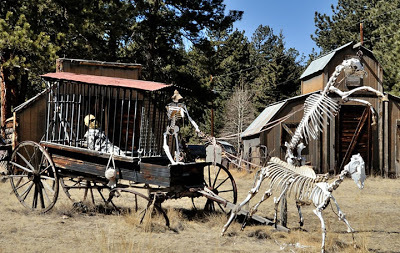




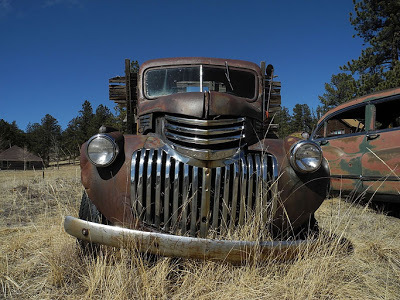
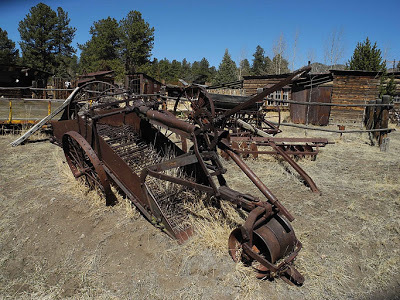
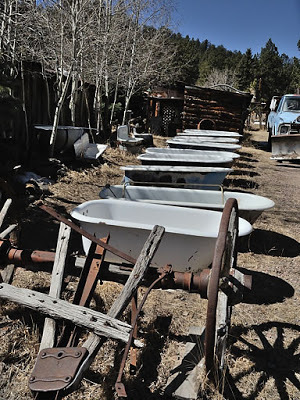
Like this post? Please share by clicking one of the links below.








Like this post? Please share by clicking one of the links below.
Published on April 06, 2012 04:00



